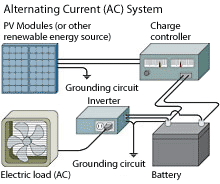Going off the grid? Don't forget your 12v solar panel!
One of the greatest advantages of solar panels is their versatility. You can string together thousands of them to build utility-scale solar parks, or you can hook up a single panel with a battery to power your off-grid adventures. While in theory you can just go to the nearest Walmart and put a 12v solar panel kit in your shopping cart, you really need to know what you are shopping for before you whip out that credit card.

Watts, Watt-hours, Volts, Amps: A Gentle Introduction
Before we get into the specifics of a 12v solar panel, let's define some terminology. Knowing how power relates to energy, voltage, and current is essential for understanding a solar panel system. This is especially true for off-grid systems since you need to make some decisions on the appropriate voltage and power requirements before you start ordering anything. A watt (W) is a unit of power, and power is the rate at which energy is produced or consumed. For instance, a 100 W light bulb uses more energy in the same time as a 60 W light bulb. A watt-hour (Wh) is an unit of energy. Running a 100 W light bulb for an hour uses up 100 Wh of energy. Running it for two hours uses up 200 Wh of energy. Power companies often use the term kilowatt-hour (kWh) which is just equal to 1000 Wh.
Power is related to two other important factors called voltage (v) and current (I). Voltage is measured in volts (v) and current is measured in amps (A). Power is simply voltage multiplied by current (P = v*I). An analogy to understand this is water running through a pipe. The voltage is analogous to the water pressure and the current is analogous to the the flow rate. A higher pressure or a higher flow rate leads to a greater quantity of water delivered at any given time. Similarly, a higher voltage or a higher current leads to greater power generated or consumed for an electric system.
For batteries, another factor called charge is typically used as a battery rating. It is commonly defined as ampere-hour (Ah) which is the current multiplied by the time. A battery has a limited amount of charge that it can hold and it will run out of juice in a given amount of time depending on the current. For instance, a battery which has a rating of 100 Ah can delivers 5 amperes for 20 hours or alternatively 10 amperes for only 10 hours. Depending on your wiring system and appliance needs, you should find a battery which is best suited for your needs.
Five Things You Need to Consider Before Going Off-Grid
As with anything in life, independence comes with a price. Going off-grid is much harder than staying connected to the grid as you need to choose and maintain your own power generation equipment. Whether you are considering off-grid solar solutions for your boat, RV or cabin (check out the specific articles for each if you want more information), here are five factors you should consider:
- When connected to the grid, solar panels don't suffer very high losses. However, charging batteries is another matter. Batteries may cause you to lose 30-40% of your solar electricity as charging them always results in losses. Thus, when sizing your system, keep in mind that you can lose from one third up to almost half of the solar power actually generated.
- Using solar power as your only source of electricity may not always be a good idea. Inevitably, your solar panels will generate less power on cloudy or snowy days. If there are many back-to-back days of very little sunshine, your battery bank will eventually be depleted. Thus, you may need to invest in a large battery bank to cover worst-case weather scenarios, or purchase a backup generator (such as a traditional diesel generator).
- You need to take into account the seasonal variations in your generation and consumption patterns. If you are connected to the grid, you can sell the excess solar power back to your utility company (or use net metering to credit your account). However, excess power can be a headache with an off-grid system. For safety reasons, you don't want to overcharge your batteries and a charge controller will be essential to cut off the excess generation.
- Only grid-connected systems are eligible for some of the tax credits, rebates and incentives for solar energy. If you live in the U.S., you may still be able to benefit from the 30% federal solar tax credit for your off-grid system, but you need to read the fine print.
- Adding batteries to your solar setup will increase the need for maintenance and you may need to replace your deep-cycle batteries every 10-15 years. In contrast, a grid-connected system requires minimal maintenance.
12v, 24v, or 48v System Voltage?
Choosing the voltage of your off-grid system is a key decision, as it will have a major impact on the type of equipment you will need. Some popular wiring choices are 12v, 24v, or 48v. A 12v solar panel system will need larger wires but on the flip side you will have more choices and better prices when it comes to some of the electrical equipment you need. Also, if you need to power devices on your boat or RV that need 12v DC input, then a 12v system would be a better fit. Otherwise, you can use an inverter with a 24v setup for a medium-size AC installation or even 48v for larger AC systems. The higher voltage you go, the thinner wires you will need and consequently the less losses you will have. However, with a higher voltage system, you do pay the penalty of a more expensive system and face an increased risk of an electric shock or even a fire if you are not careful.
A Typical Off-grid Setup
Now that you have decided on your system voltage, we can go through the list of components you need and what to look for in an ideal setup. There is a wide range of choices for each piece of equipment with many manufacturers competing for your business. Price, performance, and reliability can vary greatly between manufacturers. Providing specific details is beyond the scope of this article but a short introduction can give you a good idea.
1) Solar Panels
With the system voltage decided, there are a variety of solar panels available which can work with either 12v, 24v, or 48v setups. Deciding on the size and location of solar panels is also important. For a cabin, mounting panels on the roof is good for security, aesthetics, and convenience. It can also lower roof temperatures in hot climates. However, if the panels need to be cleared of snow or dust regularly, the roof may not be the ideal location. A rough sizing estimate is that a 200-W panel takes about 5 feet (1.5 meters) by 3 feet (1 meter) and weighs about 40 pounds (18 kilograms).
2) Charge Controller
With the system voltage decided (12v, 24v, 48v), there is a wide selection of charge controllers available for the particular system voltage. The charge controller ensures that the batteries are fed a proper amount and rate of power. Traditionally, a Pulse-Width-Modulation (PWM) controller is used which is fairly cheap and sends spikes of charge into the batteries. Alternatively, for higher efficiency, a Maximum Power Point Tracking (MPPT) controller can be used. MPPT charge controllers provide about 30% more power and they can be used in higher voltage systems. However, they tend to be more pricey than PWM controllers.
3) Batteries
The two types of batteries applicable are both deep cycle batteries: flooded batteries or sealed batteries. Deep cycle batteries allow a regular discharge between 45% - 75% of its capacity. Flooded lead acid batteries are the most common and they are fairly cheap. However, they require venting, they discharge hydrogen, they need to be refilled with water and they can leak acid if they are damaged. Alternatively, using a significantly more expensive sealed battery such as an Absorbed Glass Mat (AGM) battery eliminates all these issues, as well as the maintenance concerns. Never use a starter battery such as the one in your car since it outputs short high-current bursts which does not provide a constant source of power for your needs.
Batteries can either be arranged in series (linked one after the other on one continuous wire) or in parallel (beside each other, each with their own wire) to provide either more voltage or current respectively. You can also connect two 6v batteries in series to provide 12v and then connect several of these setups in parallel to increase the current.
4) Inverter
If you are running AC power appliances which are the most common kind for household appliances, you will need an inverter to convert from DC to AC. Note that inverters are not 100% efficient, and DC to AC conversion can cause a loss of around 20%. If you are just running a laptop and a few small devices, you can use a small inverter (around 300W). For larger appliances, you will need a larger inverter on the order of 1kW or more. You have the option of using a pure sine wave inverter or a modified sine wave inverter. The pure sine wave inverter provides a smoother power curve.
5) Fuses and Breakers
Fuses, breakers, and disconnects should be installed between the solar panels and charge controllers, between the charge controllers and batteries, and between the batteries and inverters (if necessary) to stop the current flow in a region of the system if issues arise. These parts will not only make regular maintenance simpler, but they will also increase the overall safety of your system.
6) Wiring
Wires need to connect all the components together. The system voltage will directly correlate with the wiring size and an optimal wire should be chosen to prevent the least amount of voltage drop. A 3% drop is considered the maximum limit. Note that choosing too small of a wire will create heat and possibly a fire.
7) Battery Monitor
A battery monitor is essential to know how much juice you have left in your batteries. An amp-hour meter on the battery is the best choice since it will give you details on the amount of charge left in your batteries. We don't recommend using a standard multimeter since it only provides information on the voltage and amperes at that moment, and does not give you any indication on the amount of charge left.
Our Verdict: Off-grid solar is good, solar plus the grid is even better
If you live in a remote location or you're in a moving vehicle (such as an RV or a boat) and want your own independent power source, going off-grid with solar panels is probably your most economical and convenient choice. Silent operation, no moving parts and a relatively low amount of maintenance make solar an appealing option. Moreover, the component prices continue to decrease, making solar more competitive from a financial point of view. However, for most home owners, a grid-connected system is still the most logical choice. Grid-connected systems are far simpler, less expensive, and qualify for more tax credits and other financial incentives. If you cut the cord and go off-grid, make sure to invest sufficient time in your initial research and planning in order to design a reliable and safe system. So what next? Why not use WhatNextNow Solar Discover to evaluate the solar potential of your next off-grid destination?
